Beit Shemesh
Beit Shemesh (Hebrew: בֵּית שֶׁמֶשׁ, Latin: Bethsames, Beth Shamesh, Bethshamesh or Bet shemesh and most often Beth-Shemesh in English translations of the Hebrew Bible) is a city located approximately 30 kilometres (19 mi) west of Jerusalem in Israel's Jerusalem District, with a population of 124,957 in 2019.[1]
Beit Shemesh
| |
|---|---|
| Hebrew transcription(s) | |
| • ISO 259 | Beit Šemš |
| • Also spelled | Bet Shemesh (official) |
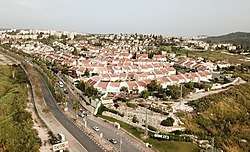 | |
 Emblem of Beit Shemesh | |
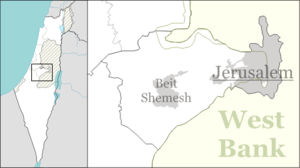 Beit Shemesh  Beit Shemesh | |
| Coordinates: 31°44′44″N 34°59′12″E | |
| Country | |
| District | |
| Government | |
| • Type | City |
| • Mayor | Aliza Bloch |
| Area | |
| • Total | 34,259 dunams (34.259 km2 or 13.227 sq mi) |
| Population (2019)[1] | |
| • Total | 124,957 |
| • Density | 3,600/km2 (9,400/sq mi) |
| Name meaning | House of the sun |
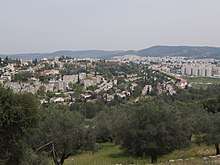
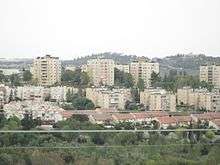

Etymology
Beit Shemesh means "house of the sun" or "temple of the sun" in Hebrew. The Bronze-Age city was originally named after the Canaanite sun-goddess Shapash, sometimes called Shemesh, who was worshipped there in antiquity.[2]
The name Beth-Shemesh was shared by (at least) two other places in Israel and one more in Egypt.[3]
In the Amarna letters Shamash is mentioned several times, along with Addu, as one of the greatest gods: the Pharaoh is "like Addu and Shamash".[4]
History and biblical tradition
Canaanite and Israelite town
The Canaanites of Beit Shemesh named the city after Shapash/Shemesh, the sun-goddess they worshipped. The ruins of the ancient biblical city of the Canaanites and Israelites are located at a site called Tel Beit Shemesh in Modern Hebrew and Tell er-Rumeileh in Arabic, a tell located near the modern city.[2]
Book of Joshua
Beit Shemesh is first mentioned in the Hebrew Bible in the Book of Joshua (Joshua 15:10), as a city in the territory of the tribe of Judah on the border with the tribe of Dan. In Joshua 21:16, this city was set aside as one of the 13 Kohanic cities for the priests of the tribe of Levi, the Kohanim.
Another city by the same name, Beit Shemesh, is later mentioned in Joshua 19:38, being situated in the territory of the tribe of Naphtali.
Book of Samuel
The city located in the territorial bounds of the tribe of Judah is mentioned in the 6th chapter of 1 Samuel as being the first city encountered by the Ark of the Covenant on its way back from Philistia after having been captured by the Philistines in battle (1 Samuel 6:12-21). The stone on which the Ark was placed is recorded as still being located there at the time of writing the Books of Samuel. In the King James Version this stone is described as "the great stone of Abel" (1 Samuel 6:18).
Book of Kings
In 2 Kings 14, Beit Shemesh is again mentioned as being the site of the battle between King Amaziah of Judea and King Jehoash of Israel.
Assyrian destruction to Early Second Temple period
After the destruction of much of Judah by Sennacherib in 701 BCE, the city was abandoned for a while, but there seems to have been an attempt by a group of Judahites at resettling Beth Shemesh, judging by the refurbishing of the water reservoir in the 7th century BCE.[5] However, after the Babylonian conquest of Judah in the early 580s, either the new Babylonian rulers, or the nearby Philistine metropolis of Ekron favoured by them, apparently put an end to the initiative by sealing and covering over the vital water reservoir,[5] which was not uncovered until 2004. During the first Jewish return, at the beginning of the Second Temple period, there was no lasting revival of the city, as opposed to many other places in the vicinity such as Beit Guvrin, Maresha, and others.
Byzantine period
A monastery and other remains from the Byzantine period have been found on the tell.[6]
Ottoman period
The small Arab towns of Dayr Aban and Dayr Rafat used rocks for building from Tell er-Rumeileh (Tel Beit Shemesh).
In the late 19th century the area was known as 'Ain Shems or Khirbet 'Ain Shems and was used as a temporary harvest-time residence by local Arabs.[7][8] The small mosque of Abu Mizar stood there.[8]
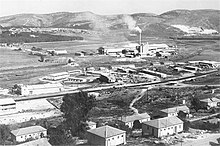
1948 war
During the 1948 Arab–Israeli War, the Egyptian army invaded the area and set up a fortified post, called "Mishlat" in Hebrew, on a hill overlooking Beit Shemesh, within the Arab village Dayr Aban. The post changed hands several times during fighting. The Harel Brigade occupied part of the post for several months, giving rise to the name "the joint post" or the "Mishlat HaMeshutaf", with 60 meters dividing them and the enemy forces. The Mishlat was finally taken by the Harel force in the Ha-Har offensive, during the night of 19–20 October 1948.
Beit Shemesh is the point from which the so-called Convoy of 35 set out to bring provisions to besieged Gush Etzion. On 15 January 1948, a group of 38 Palmach volunteers left Hartuv near Beit Shemesh. After one member of the group sprained his ankle and returned, accompanied by two others, the group, now numbering 35, continued on its way. Their presence was discovered by two Arab women who encountered two scouts of the group near Surif. (An earlier version, that the soldiers were discovered by an Arab shepherd who they graciously let go, was based on a eulogy written by Ben-Gurion and is apparently apocryphal).[9] The Convoy of 35 was subsequently killed in fighting with Arab villagers and militiamen.
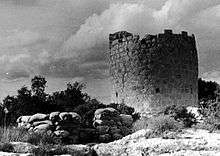 Position at Beit Shemesh fortified by Harel Brigade during Operation Ha-Har
Position at Beit Shemesh fortified by Harel Brigade during Operation Ha-Har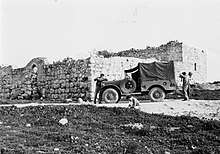 Harel Brigade position on road from Beit Shemesh to Deir 'Amr during Operation Ha-Har, 1948
Harel Brigade position on road from Beit Shemesh to Deir 'Amr during Operation Ha-Har, 1948 Beit Shemesh 1947 1:20,000
Beit Shemesh 1947 1:20,000
State of Israel
On 6 December 1950, the Hartuv displaced persons camp "Ma'abarat Har-Tuv" was established on the site of the current-day Moshav Naham. The first inhabitants were Jewish Bulgarian immigrants. They were joined by more Jewish immigrants from Bulgaria, Iran, Iraq, Romania, Morocco and Kurdistan. In 1952 the first permanent houses were built in Beit Shemesh. Prior to 1948 the Ramat Beit Shemesh neighborhood area was the site belonging to the Arab village Bayt Nattif. This village was built on remnants of an ancient Judean town, with various remnants of Jewish settlement from the time, such as a mosaic floor, wineries and other remains, especially from the period of the Hasmonean kings and earlier. This area is currently under dispute about preservation, having been the subject of a grassroots campaign.
In its early years, Beit Shemesh came to typify the "Development Town" with a largely North African immigrant population. In 1977, following a writeup in Haaretz newspaper, Beit Shemesh was perceived as the main outpost for Menachem Begin's Likud party. He promised to rehabilitate neighborhoods and when Likud came to power that year, investment in the city increased.
The Israel Police maintains a bomb disposal specialist unit and training center in Beit Shemesh.[10]
Demographics
| Year | Pop. | ±% |
|---|---|---|
| 1955 | 3,000 | — |
| 1961 | 7,000 | +133.3% |
| 1972 | 10,100 | +44.3% |
| 1983 | 13,000 | +28.7% |
| 1995 | 24,900 | +91.5% |
| 2008 | 72,700 | +192.0% |
| 2018 | 118,700 | +63.3% |
| Source: CBS | ||
When the city was built in the 1950s, it was initially settled by new immigrants from Iran, Iraq, Romania, Bulgaria, Morocco and Iraqi Kurdistan. In the 1990s, the city saw a large influx of new immigrants from the former Soviet Union, Ethiopia and English-speaking countries, turning it into a major center for Anglo immigrants. Considerable numbers have come from North America, the United Kingdom, South Africa and Australia. This population tends to be Orthodox, educated and from middle income groups. At the same time, Orthodox Jews from within Israel also began moving to the city, seeking roomier, low-cost housing.[11][12]
According to a city councillor, there were no Haredim in Beit Shemesh before the 1990s.[13] Since then, Beit Shemesh has become increasingly religious, with a large Haredi sector. Many synagogues and yeshivas have been built in the city. Religious communities represented in Beit Shemesh include Ger, Belz, Shomer Emunim, Satmar and Neturei Karta. In 2011 Haredim made up 40% of the population, of which an estimated 50 or 60 families with great influence are militant.[13] According to statistics published by the municipality, 63% of the city's schoolchildren in 2010 were Haredim.[14] 75% of the children entering the first grade in the 2012/2013 academic year will be registered in official Haredi institutions.[15]
The population of Beit Shemesh is expected to reach 150,000 in 2020.[14]
Urban development
Two new areas, the Nahala UMenucha neighborhood, and Ramat Beit Shemesh, were built in the 1990s, doubling the size of the city.
Ramat Beit Shemesh
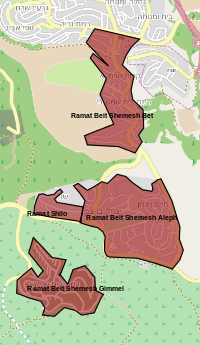
Ramat Beit Shemesh (Hebrew: רמת בית שמש, "Beit Shemesh Heights") is an expansion that lies directly adjacent to, and to the south of, the original part of Beit Shemesh, colloquially referred to as "Old Beit Shemesh". It is located on a hill overlooking the old town. Ramat Beit Shemesh has a large, diverse Orthodox population. Originally, it consisted of two areas: Ramat Beit Shemesh Alef and Ramat Beit Shemesh Bet. In Ramat Beit Shemesh Bet, families belonging to Eda Haredit constitute the majority.[14] In 2002, following tensions between the Haredi and non-religious population, plans were drawn up to build another secular neighborhood, HaShachar. In 2007, Ramat Shilo, considered a subdistrict of Ramat Beit Shemesh, with both Dati Leumi and Haredi residents was built. In 2009, it was announced that a new neighborhood, Ramat Beit Shemesh Gimmel, would be built as a largely Haredi neighborhood on a large block of state-owned land bordering southern Beit Shemesh.[14] In 2016 the Israeli Land Authority published tenders for 3,268 new apartments, to be built in the newly proposed areas of Ramat Beit Shemesh Dalet and Hey. According to plans, ultimately there are to be 8,300 new apartments in RBS Dalet alone.[16]
Ramat Beit Shemesh Aleph
Ramat Beit Shemesh Aleph is a neighborhood of Beit Shemesh comprising about 25,000 people. The neighborhood has numerous parks and public areas being well maintained. The central park is Ayalon Park, the biggest in Beit Shemesh. Shopping is plentiful as well, with 4 supermarkets and a shopping area of over 130 shops to choose from, one is never lacking a place to make his purchases. Although all types of Jews are welcome in all parts of RBS A, there are a few different sections each with its own unique touch and strong points. There is the Dolev section, the Revivim section, and the Mishkenos Yaakov section.
The Dolev section contains a heterogeneous mix of different types of Jews, both native Israelis and immigrants. Religiosity varies as well from Chareidi until Masorti or Dati Leumi. While each group has its own synagogues and schools, in general, the population in the area blends together to form a beautiful cacophony of different ways of doing the same thing. For example, Masos/Masot Mordechai is a place where all types come together to pray at all times of the day. Points of interest in the Dolev section are the Matnas, a community center that services all types of Jews of the RBS A community, and Park Center, a mini-mall of various stores and restaurants. Streets include Dolev, Shimshon, Timnah, Yarkon, and Yarden.
The Revivim section is lower down than Dolev. This area is populated mostly by Chareidim, both Israeli and Chutznikim, with religious levels ranging from American Frum all the way to a few Yerushalmis. With the majority being Chutznik, much of the neighborhood is connected to an American Minyan such as the Gra, Pnei Shmuel, or others. There is a big emphasis on living a Torah lifestyle which pervades the area. Streets include Revivim, Ramot, Gilo, Noam, and Achziv. (A way to remember these streets is their geographic location, from west to east, and from lower to higher on the hill. After Noam, come the GRA streets (Gilo, Ramot, Achziv), which culminate near the GRA shul.)
The Mishkenos Yaakov section is located next to the Merkaz (central shopping area). Here lives almost only Chareidim, both Israelis and Chutznikim, although the Chuznikim tend to lean towards their Israeli counterparts regarding religious/cultural issues. There is an official Rav (Mara D'Asra), Rav Mordechai Goldstein (son of Rav Tuvia ztl), who is looked up to as the respected opinion regarding religious questions and community projects. Points of interest in the Mishkenos Yaakov area include Lev Eliyahu, the synagogue with the most Minyanim in all of RBSA (and most likely the most hasmada (diligence in Torah study), and the Merkaz, the shopping center more than 130 stores of all types. Streets include Sorek (lower half), Kishon, Uriah, Micha, and Shacham.
A further expansion to Ramat Beit Shemesh is the leafy suburbs of Mishkafayim located at the eastern edge of Aleph overlooking the Zanoah quarry. The area, still under development, has started to be populated. The make up is entirely by Orthodox Jews of all strands including Chasidish, Hareidi and Dati Leumi. The area currently has 6 minyanim.
Organizations based in Ramat Beit Shemesh Aleph include:
- Lema'an Achai – A social services charity that has successfully assisted hundreds of families through and out of financial and other crisis
- Hatzola Beit Shemesh – An independent organization combining first response and follow-up care of emergency medical situations.
- Kupa Shel Tzedaka – A charity organization helping needy families to rehabilitate them to self-sufficiency. (Mishkenos Yaakov has a separate organization for their needy families.)
- Ezrat Achim – A medical aid organization such as trips to the hospital, x-rays, and loan of medical equipment.
- Mishkan Adei Ad – An organization which assists needy families with the vast expenses of making weddings.
- Hakeshiva – An organization which focuses on the prevention of, and the aiding of teens-at-risk.
Ramat Beit Shemesh Bet
Here live mostly all Charedim. Of those Charedim, most of them are Hasidic of various dynasties.
Ramat Beit Shemesh Gimmel
Ramat Beit Shemesh Gimmel is located just south of Ramat Beit Shemesh Aleph. Gimmel consists of two parts, Gimmel 1 and Gimmel 2. Gimmel 1 is already populated with about 2,000 apartments, Gimmel 2 is currently under construction. With its lowers density building and larger apartments as well as the many open spaces and parks Gimmel 1 is seen as more appealing to the Anglo-Saxon public. Gimmel 1 is officially named "Kiryat Avi Ezri", while Gimmel 2 is named "Kiryat Ovadia".
Gimmel 1 developed into a thriving neighborhood in a very short time and as of 2018 has many synagogues, stores, clinics and schools. Some of the communities and synagogues started by the large community of English-speaking residents include;
Nusach Sfard
- Ahavat Shalom – Rabbi Doniel Faber
- Kol Yehuda – Rabbi Shimon Twerski[17]
Nusach Ashkenaz
- Dvar Avraham – Rabbi Eliezer Greenberg
- Darkei Yitzchok – Rabbi Baruch Dzialowski
- Ezra Hasofer – Rabbi Tzadok Cable[18]
- Tifferes Yisrael – Rabbi Tzvi Miller
- Zichron Chaim Pinchas – (Formerly) Rabbi Moshe Goldstein
Ramat Beit Shemesh Daled
Currently (2020) under construction. Expectations are to have residents move in within the year.[19] It is expected that the population will be mostly Chareidi.[20]
Ramat Beit Shemesh Hey [Neve Shamir]
Currently (2020) in construction.
The neighborhood would be non-Chareidi[21] and it was designed like non-charedi neighborhood. Some of the apartments were marketed as part of mechir lamistacan. The rest in the private market. In addition, housing units will be built for permanent staff and security forces. Buildings like Country club, mamlachthi and mamlachti-dathi schools will be bulit.[22]
According to the city mayor, Aliza Bloch, "We are witnessing a group of purchasers of residents of Beit Shemesh being divided among the general public, another group outside the city, such as: Gush Etzion, Mevaseret Zion and Jerusalem, and a group of people from abroad, mainly from the US, a community-oriented population such as the Sheinfeld neighborhood. Just a year ago, I toured the US and met with many groups whose fruits are for the encounters that I see there today. In addition, we try to interest the teachers' union, such as the Ashmoreth group, where teachers and education people, the Neve Shamir neighborhood is of interest to them." In may 2020, Dozens of national and secular religious couples (hiloni and dathi leomi) took part in a tour of the Neve Shamir neighborhood with Mayor Aliza Bloch and her deputy. Those in attendance answered current questions and information from the field. In light of the success of the reunion, more tours were held.[23]
Ramat Shilo
Ramat Shilo was built in 2007 with 340 housing units geared toward Modern Orthodox Jews.[24] Since then, the neighborhood has experienced rapid growth and development. The residents of Ramat Shilo are Orthodox Jews, both Dati Leumi and Haredi. The neighborhood has a large community of English-speaking olim. Its residents are both Ashkenazim and Sephardim.
Ramat Shilo has a number of synagogues, yeshivas and kollels.[25] The largest institution is Yeshivat Lev Hatorah, a Religious Zionist yeshiva founded by Rabbi Boaz Mori.[26] The local synagogues include Beis Dovid/Pilzno Beis HaMedrash, a Hasidic synagogue representing the Pilzno Hasidic dynasty under the leadership of Rabbi Yehoshua Gerzi,[27] Mishkan Shilo, an Ashkenazi synagogue under the leadership of Rabbi Dovid Bagno,[26] Mishkan Moshe Va'Eliyahu, a Sephardi synagogue under the leadership of Rabbi Shai Naftali,[28] and Ohev Yisroel, a Hasidic synagogue under the leadership of Rabbi Binyomin Flintenstein of the Kapishnitzer Hassidic dynasty.[29]
Notable residents of Ramat Shilo include:
- Rabbi Avraham Jacobovitz, founder of Machon L'Torah and Jewish Awareness America (JAAM)
- Rabbi Dr. Howard Apfel, Cardiologist at Columbia University Medical Center.
- Rabbi Yehoshua Fass, founder and executive director of Nefesh B'Nefesh
Among the communal organizations is Chasdei Shilo which provides assistance for families with financial difficulties as well as serves as a communal resource network.[30]
Urban kibbutz Tamuz
Beit Shemesh also has an urban kibbutz affiliated with the Kibbutz Movement, Tamuz, founded in 1987.
English-speaking community
The large English-speaking community is concentrated in Ramat Beit Shemesh Alef, as well as in the Sheinfeld, Nofei Aviv, Migdal HaMayim, and Nofei HaShemesh neighborhoods in the Givat Sharett section of the city.
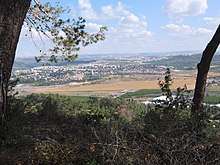
Masterplan and development
Beit Shemesh is developing rapidly, and under a current masterplan approved by the Israeli government in 2017, Beit Shemesh will double in population, to more than 200,000 residents, with 17,000 new housing units built along with 130 acres zoned as new commercial space for businesses and hotels.[31][32] It is expected that the city could be home to as many as 250,000 residents by 2025. A new commercial center in the Ramat Beit Shemesh neighborhood is planned to be the city's largest.[33]
Local government
The current mayor of Beit Shemesh is Dr. Aliza Bloch, she assumed office in November 2018 after extremely close elections which in the end got her the win by the votes of the IDF soldiers from Bet Shemesh. She is also the first female mayor of Beit Shemesh.[34]
The previous mayor of Beit Shemesh was Moshe Abutbul, a member of Shas. The deputy-mayor, Shmuel Greenberg, is a member of United Torah Judaism (UTJ).[15] Haaretz quotes Abutbul as saying: "Beit Shemesh is not a Haredi city and will not be one."[14] In the 2009 elections, Shas and UTJ won nine seats in the 21-seat municipal council, one seat went to a new Haredi party called Tov.[14]
Formerly a Likud stronghold, in the 2006 Knesset elections United Torah Judaism became the city's strongest party, with 22.2 percent of the votes and Shas getting 19.9 percent. In 2009 Likud regained its primacy, obtaining 22.2 percent of the votes, and Shas also gained, garnering 20.9 percent, with United Torah Judaism a close third at 20.6 percent. Eda Haredit boycott the elections.[14]
2013 municipal elections
During the municipal elections held on 22 October 2013, acting on several anonymous tips, police raided several private residences and recovered 200 ID cards and disguising materials such as hats, glasses and wigs which law enforcement suspected were used or going to be used for fraudulent voting. Additionally, eight people were arrested on suspicion for engaging and coordinating fraudulent voting activities.[35]
On 10 December 2013 a three judge panel of the Jerusalem District Court nullified the results of the October municipal elections due to voter fraud and ordered a new election.[36]
Following an unprecedented 76% voter turnout rate, incumbent mayor Moshe Abutbul beat contender Eli Cohen with a 51% majority vote during the reelection which took place on 11 March 2014. [37]
Education
In 2001, there were 56 schools and 14,148 students in the city: 41 elementary schools with 10,716 elementary school students, and 20 high schools with 3,432 high school students. 40.3% of 12th grade students were entitled to a matriculation certificate.
Economy
Beit Shemesh has two industrial zones containing mainly small industry, particularly in the Northern industrial zone which is typified by carpentry and metalwork workshops, garages and wholesale and retail outlets. The Western industrial zone contains several larger companies including Beit Shemesh Engines Ltd. (BSEL) which manufactures and repairs jet engines and jet engine components, Barzellan and others. Nearby in the Noham industrial zone are situated various other factories and offices. Since the hi-tech boom of 1996–2001 Beit Shemesh has been host to several hi-tech startups including Omek Interactive.
Transportation
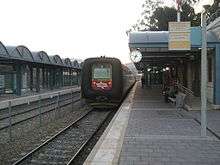
Beit Shemesh Railway Station provides hourly service on the Israel Railways Herzliya–Lod–Jerusalem line. The station is located in the north industrial zone of Beit Shemesh. It was reopened on 13 September 2003, having existed for over a century at the same location.[38] The station has three platforms.
Bus transportation within Beit Shemesh and most inter-city routes is operated by Superbus, which began service on 5 January 2009.[39] The Egged Bus Cooperative, which previously operated all bus service in and to Beit Shemesh, still operates a limited number of bus lines from Beit Shemesh to Jerusalem.
Sports
Beit Shemesh is home to numerous sports clubs all under the main sport associations (Beitar, Hapoel, and Maccabi). The city has soccer teams including juniors, seniors and over-35s teams and boasted a franchise in the Israel Baseball League. The Beit Shemesh Blue Sox represented Beit Shemesh in the league's only season, though they played their games at Gezer Field in Kibbutz Gezer due to a lack of proper facilities in Beit Shemesh. There is also a very active Little League in Beit Shemesh and Ramat Beit Shemesh, with over 300 members. In the field of judo, Elitzur Beit Shemesh has won many prizes. Israel Kung Fu and world Nunchaku champion (2001) Eli Ivgi was born in and lives in Beit Shemesh. Construction of a regulation-sized baseball field in Bet Shemesh is planned. The ground-breaking ceremony taking place on January 6, 2017.[40]
Arab-Israeli conflict
On 13 March 1997, seven 13 and 14-year-old girls from Beit Shemesh's AMIT Fuerst School were killed at the "Island of Peace" site in Naharayim by a Jordanian soldier while they were visiting the joint Israeli and Jordanian tourist resort under Jordanian rule on a class trip.[41] King Hussein of Jordan went to Beit Shemesh a few days after the massacre to extend his condolences and ask forgiveness in the name of his country, a step which was seen as both courageous and touching.[42]
Gender issues and inter-communal tensions
In 2004 the Israel Association of Ethiopian Jews claimed that Ethiopian Jews working for the municipality were being paid below-minimum wages.[43] In 2011, the Association criticized the referral of Ethiopian Jews to three private pre-schools run by the mayor's wife.[44]
According to The Jerusalem Post, women who belong to a Haredi burqa sect in Beit Shemesh were ostracized by the Haredi community.[45] The leader of the movement, dubbed the "Taliban mother" by the Israeli press, was convicted by the Jerusalem District Court in 2009 on three counts of abuse of a minor and 25 counts of assault in aggravated circumstances, and sentenced to four years in prison. Her husband was also convicted of 10 counts of assault and three counts of abuse of a minor or helpless person, and was sentenced to six months in jail.[46][47]
In 2011, conflicts erupted in Beit Shemesh between extremist ultra-Orthodox men, possibly members of a group known as the Sikrikim,[48][49][50] and other residents of the town due to gender separation at local health clinics,[51] and so called ‘mehadrin buses’ where men sit in the front and women in the back.[52]
When the municipality removed a sign asking women to stay away from a synagogue, hundreds of Haredi men staged riots in which they attacked police officers and reporters.[53][54] Several placards urging segregation between men and women were put back after being removed by the police.[55]
After the opening of Orot Banot national-religious girls’ school in September 2011, groups of Haredi extremists gathered in front of the school, calling the girls names and spitting at them when they headed to and from school. Stones hurled at a boys' school belonging to the same educational network injured a boy in the leg. Two men were arrested on suspicion of throwing eggs and tomatoes at students.[56] In a demonstration outside the school a female journalist was assaulted by young Haredi men who cursed and spat at her, and a clash with parents of girls studying at the school was broken up by the police force.[56]
In December 2011, a public outcry was raised when a television news channel interviewed 8-year old Na'ama Margolese, who was cursed and spat at on her way to school by Haredi extremists.[57] The Jewish Daily Forward reported that the issue is really a property dispute over ownership of the school building.[58] Some Haredi women distributed flowers to the girls of Orot Banot school, telling them "sister to sister" that they were beautiful.[13] On 27 December 2011, a protest against extremism near the Orot Banot school drew 10,000 people.[59][60] After the incidents in Beit Shemesh were reported in foreign press, the US State Department updated its Jerusalem travel advisory advising visitors to "dress appropriately" when visiting ultra-Orthodox Jewish neighborhoods, or to avoid them entirely.[61]
Na'ama's mother Hadassah Margolese who has repeatedly spoken out on behalf of national religious Beit Shemesh residents against Haredi tendencies,[62] including about an occurrence in which little girls' faces were blurred out on Purim advertisements distributed in her neighborhood,[63] and a humiliating experience at the ritual bath reportedly left Beit Shemesh with her family in late July 2013 after being attacked by members of her own national religious community who accused her of exposing the community to public shame.[62]
in February 2015 Judge David Gideoni accepted a claim filed by four women who protested an illegal "modesty sign" posted in Ramat Beit Shemesh Bet. The judge ordered Mayor Moshe Abutbul and the Beit Shemesh Municipality to pay each of the women complainants NIS 15,000. The city then saw further signs of "religious radicalization" when the word "woman" was repeatedly erased from a sign at a women's health center.[64]
Archaeology
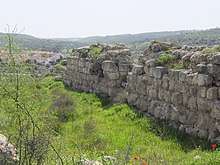
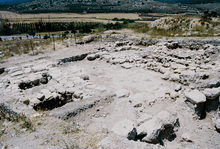
In 1971, excavations at Givat Sharett conducted by Israeli archaeologist Claire Epstein revealed a residential settlement of the Middle Bronze Age, including a temple.[65]
The most ancient iron workshop in the world was discovered in Beit Shemesh in 2003. The only remnants of a fortified city with an advanced water system, from the time of the early Kingdom of Judah was found here. The bones of animals found in the 12th–11th centuries BCE layer indicate a diet typical of the Israelites who inhabited the hill country in this period. These together with the pottery finds indicate the cultural influences on the inhabitants of this border town. However, it is not possible to determine their specific ethnic identity, which could be Canaanite, Philistine or Israelite.[2]
In August 2012 archaeologists from Tel Aviv University announced the discovery of a circular stone seal, approximately 15 millimetres in diameter. The seal was found on the floor of a house at Beit Shemesh and is dated to the 12th century BCE. According to Haaretz, "excavation directors Prof. Shlomo Bunimovitz and Dr. Zvi Lederman of Tel Aviv University say they do not suggest that the human figure on the seal is the biblical Samson. Rather, the geographical proximity to the area where Samson lived, and the time period of the seal, show that a story was being told at the time of a hero who fought a lion, and that the story eventually found its way into the biblical text and onto the seal."[66]
Animal bones found nearby may also be a clue to boundary disputes between different cultures. Pig bones have been found a few kilometres from Beit Shemesh, but only a few have been found actually at Beit Shemesh and at some point during the 11th century BCE it appears that the local population stopped eating pig. Haaretz reports that "According to Bunimovitz, when the pork-eating Philistines arrived in the country from the Aegean, the local people stopped eating pork to differentiate themselves from the newcomers."[66]
In 2014, archaeologists Irene Zilberbod and Tehila Libman announced the nearby discovery of a large compound from the Byzantine period that was most probably a monastery.[67] It comprised a residential area and an industrial area with wine and olive presses.[67] The remains of buildings with two or three stories and impressive mosaic floors were discovered.[67] The compound ceased to function in the early Muslim period and was subsequently occupied by other residents.[67] The excavations were continuing with additional finds through late 2017.[68]
Twin towns – sister cities
Beit Shemesh is twinned with:[69]






In the Partnership 2gether program of the Jewish Agency for Israel, Beit Shemesh and the Mateh Yehuda Regional Council are linked to South Africa and Washington, D.C.[70]
After The Washington Post'' reported in October 2011 that Montgomery County, Maryland was considering a partnership with Beit Shemesh,[71] a local coalition, Human Rights Matter!, objected.[72] The campaign was supported by the Mossawa Center, an organization that defines its goal as the promotion of equality for the Arab minority in Israel but which has been criticized for its rejection of Israel as a Jewish state and its foreign funding from the European Commission, George Soros's Open Society Institute and the New Israel Fund, among others,[73] as well as Nobel Peace Prize laureate Mairead Maguire.[74]
Notable residents
- Nili Block (born 1995), world champion kickboxer and Muay Thai fighter
- Adam Edelman (born 1991), American-born four-time Israeli National Champion in skeleton event, and Israeli Olympian
- Ari Goldwag (born 1979), singer, songwriter, composer, and music producer
- Hezekiah (born 739 BC), King of Judah[75]
- Shmuel Kozokin (born 1987), footballer
- Tahounia Rubel (born 1988), fashion model and television personality
- Natan Slifkin (born 1975), "Zoo Rabbi", director of the Biblical Museum of Natural History and Author on the topics of zoology and science
- Jamie Geller (born 1978), American-born food writer, celebrity chef, television producer and businesswoman.
- Rabbi Avraham Jacobovitz, founder of Machon L'Torah and Jewish Awareness America (JAAM)
References
- "Population in the Localities 2019" (XLS). Israel Central Bureau of Statistics. Retrieved 16 August 2020.
- Beit Shemesh – Biblical city on the border between Judah and Philistia Archived 14 August 2007 at the Wayback Machine, Israel Ministry of Foreign Affairs. Retrieved 23 November 2007.
- BibleHub.com, Beth Shemesh, quoting Strong's Concordance etc. Archived 8 September 2015 at the Wayback Machine
- Israel. Routledge. 2005.
- Shlomo Bunimovitz and Zvi Lederman, Beth-Shemesh: A Biblical Border City between Judah and Philistia, Tel Aviv University, 2000 Archived 5 October 2016 at the Wayback Machine, retrieved 2016-09-01
- Claudine Dauphin (1998). La Palestine byzantine, Peuplement et Populations, Vol. III: Catalogue. BAR International Series 726. Oxford: Archeopress. p. 909.
- C. R. Conder & H. H. Kitchener (1883). The Survey of Western Palestine. III. London: The Committee of the Palestine Exploration Fund. p. 60.
- M. V. Guérin (1869). Description géographique, historique et archéologique de la Palestine. Judée II. Paris. pp. 18–22.
- The legend of ambushed Palmach squad '35' Archived 21 July 2018 at the Wayback Machine Haaretz, 27 April 2009
- Omri Efraim. Israel Police get 1st female sapper Archived 2 April 2015 at the Wayback Machine, Israel News, 20 September 2011.
- "Archived copy". Archived from the original on 17 December 2016. Retrieved 13 October 2016.CS1 maint: archived copy as title (link)
- Nathan Jeffay (15 January 2009). "Building a Bit of America in Beit Shemesh". The Jewish Daily Forward. Archived from the original on 6 January 2012. Retrieved 30 December 2011.
- Sherwood, Harriet (31 October 2011). "The battle of Bet Shemesh". The Guardian. Archived from the original on 12 March 2016. Retrieved 18 December 2011.
- Ettinger, Yair (8 September 2010). "Black and white in color". Haaretz. Archived from the original on 2 November 2012. Retrieved 21 February 2012.
- Ettinger, Yair (8 February 2012). "Three quarters of Beit Shemesh first-graders will attend ultra-Orthodox schools next year". Haaretz. Archived from the original on 26 February 2012. Retrieved 21 February 2012.
- "Tender Publicized for 3,268 Housing Units in Beit Shemesh". Archived from the original on 13 March 2016.
- "Kol Yehuda – Ramat Beit Shemesh Gimmel | Warm, welcoming community under the guidance of Rabbi Shimon Twerski".
- "Ezra Hasofer".
- "1,603 Apartments in RBS Daled Secured by Kablanim | ShemeshPhone". www.shemesh.co.il.
- "Ramat Beit Shemesh Daled And Hey – One For Secular Residents & The Other Religious". 28 February 2019.
- "IDF Allotted Housing for Personnel in Neve Shamir (RBS Hey) | ShemeshPhone". www.shemesh.co.il.
- "בואו לגור ב'נווה שמיר'- ריאיון עם רה"ע ד"ר עליזה בלוך". SHEMESHNET.
- "נווה שמיר: עשרות זוגות השתתפו בסיור עם רה"ע בשכונה החדשה". SHEMESHNET.
- "Haredim make immodest inroads in Ramat Beit Shemesh Aleph". The Jerusalem Post | JPost.com.
- "Where to buy in Ramat Bet Shemesh Aleph".
- http://religionarticles.net/spirituality-religion/ramat-bet-shemesh-aleph-and-its-many-wonders
- Shemesh
- "משכן משה ואליהו – בית שמש (ע"ר) – מאגר עמותות". www.organizations.co.il.
- "Archived copy". Archived from the original on 26 July 2013. Retrieved 15 May 2014.CS1 maint: archived copy as title (link)
- "חסדי שילה (ע"ר) – מאגר עמותות". www.organizations.co.il.
- "Archived copy". Archived from the original on 3 September 2017. Retrieved 12 May 2017.CS1 maint: archived copy as title (link)
- "Archived copy". Archived from the original on 11 May 2017. Retrieved 12 May 2017.CS1 maint: archived copy as title (link)
- https://real-invest.co.il/?p=3558
- "Women cheered for election victories, but men are still over 95% of mayors". Times of Israel. 1 November 2018.
- 200 IDs seized in Beit Shemesh in suspected voter fraud Archived 7 January 2014 at the Wayback Machine The Jerusalem Post, 22 October 2013
- Court orders new elections in Beit Shemesh Archived 7 January 2014 at the Wayback Machine The Jerusalem Post, 26 December 2013
- Sharon, Jeremy. "Moshe Abutbul narrowly defeats Eli Cohen in repeat of Beit Shemesh mayoral election". The Jerusalem Post. Archived from the original on 12 March 2014. Retrieved 14 March 2014.
- Friedman, Jane. "SLOW TRAIN TO JERUSALEM" Archived 27 July 2018 at the Wayback Machine, The New York Times, 7 August 1983. Retrieved 23 September 2007. "Built in 1892 by the French during the Turkish reign, the Tel Aviv-Jerusalem line is one of the few early Middle East train lines to have survived the effects of wars and sands."
- סופרבוס (Superbus) Archived 3 March 2016 at the Wayback Machine (in Hebrew)
- "Bet Shemesh Municipality Agrees to Build New Baseball Field". Archived from the original on 2 January 2017. Retrieved 2 January 2017.
- Serge Schmemann (13 March 1997). "Jordanian Soldier Kills 7 Israeli Schoolgirls". The New York Times. Archived from the original on 27 July 2018. Retrieved 29 December 2011.
- "With condolence visit to Israel, King Hussein spurs talks" Archived 24 April 2009 at the Wayback Machine, CNN, 16 March 1997. Retrieved 22 July 2007. "King Hussein of Jordan knelt in mourning Sunday with the families of seven Israeli schoolgirls gunned down last week by a Jordanian soldier, saying they were all 'members of one family.'"
- "Beit shemesh program pays Ethiopian immigrants less than minimum wage". Haaretz. 27 December 2004. Archived from the original on 16 December 2014. Retrieved 18 December 2011.
- "NGO report demands end to segregation of Ethiopian students". The Jerusalem Post. 13 December 2011. Archived from the original on 18 December 2011. Retrieved 18 December 2011.
- Matthew Wagner (27 March 2008). "Beit Shemesh 'Burka' cult unveiled". Jerusalem Post. Retrieved 16 January 2012.
- Rotem, Tamar (1 June 2009). "The Trial of "Mother Taliban"". Haaretz (in Hebrew). Archived from the original on 19 June 2012. Retrieved 16 January 2012.
- "Archived copy". Archived from the original on 16 December 2014. Retrieved 15 December 2014.CS1 maint: archived copy as title (link)
- "They will come for you too". Cross Currents. 30 December 2011. Archived from the original on 8 January 2012. Retrieved 1 January 2012.
- "American enclave stands up to extremists". The Jewish Daily Forward. 29 December 2011. Archived from the original on 8 January 2012. Retrieved 1 January 2012.
-
"Beit Shemesh becomes focus point over growing outrage over violent religious extremism". The Jewish Press. 28 December 2011. Archived from the original on 9 June 2012. Retrieved 1 January 2012.
8-year-old Na’ama Margolis, the daughter of Orthodox American immigrants, was spat on by a member of the Sikrikim
- Ettinger, Yair (30 December 2011). "Ultra-Orthodox extremism is a reaction to growing reform in the community". Haaretz. Archived from the original on 26 February 2012. Retrieved 21 February 2012.
- "Yael Navon of Betar Illit Takes On Bus Gender Separation". Yeshiva World News. 31 October 2011. Archived from the original on 5 December 2011. Retrieved 18 December 2011.
- Rosenberg, Oz; Ravid, Barak; Nesher, Talila (27 December 2011). "Thousands of Israelis protest gender segregation in Beit Shemesh". Haaretz. Archived from the original on 20 January 2015. Retrieved 20 January 2015.
- Greiner, Lena; Yaron, Gil (30 December 2011). "The Ultra-Orthodox in Israel. A Clash of Cultures in the Holy Land". Der Spiegel. Archived from the original on 29 April 2012. Retrieved 8 August 2013.
- Kahana, Menahem (26 December 2011). "Jewish gender segregation protest in Israel turns violent". National Post. Archived from the original on 29 December 2011. Retrieved 20 February 2012.
- Nashoni, Kobi (21 September 2011). "Girls' school 'backed by evil regime'". ynet news. Archived from the original on 28 December 2011. Retrieved 18 December 2011.
- "Israeli girl's plight highlights extremists". Associated Press. Retrieved 29 December 2011.
- Kaplan Sommer, Allison (29 December 2011). "Letter From Beit Shemesh: American Enclave Stands Up to Extremists". The Jewish Daily Forward. Archived from the original on 7 January 2012. Retrieved 30 December 2011.
- Oz Rosenberg; Nir Hasson; Revital Blumenfeld; Barak Ravid; Talila Nesher (28 December 2011). "Beit Shemesh rally attracts thousands to protest extremism". Haaretz. Archived from the original on 28 December 2011. Retrieved 29 December 2011.
- Sharon, Jeremy (28 December 2011). "Beit Shemesh rally 'a success' say protest leaders". The Jerusalem Post. Archived from the original on 1 January 2012. Retrieved 1 January 2012.
- Chabin, Michele (6 February 2012). "U.S. tourists to Israel advised to dress modestly". The Washington Post. Archived from the original on 13 March 2016. Retrieved 20 February 2012.
- Kaplan Sommer, Allison (26 July 2013). "Symbol of struggle against Haredi coercion bids farewell to Beit Shemesh". Haaretz. Archived from the original on 5 August 2013. Retrieved 5 August 2013.
- Kaplan Sommer, Allison (31 January 2012). "In Beit Shemesh, Even Purim Is Politicized". The Jewish Daily Forward. Archived from the original on 16 March 2014. Retrieved 5 August 2013.
- Word 'woman' erased from HMO sign Archived 9 March 2015 at the Wayback Machine YNET, 9 Mar 2015
- "Claire Epstein, Jewish Women Archive". Jwa.org. Archived from the original on 15 April 2013. Retrieved 8 August 2013.
- Hasson, Nir (30 July 2012). "National Seal found by Israeli archeologists may give substance to Samson legend". Haaretz. Archived from the original on 16 November 2013. Retrieved 3 September 2013.
- Nir Hasson (20 September 2014). "Archaeologists discover impressive Byzantine-era compound near Beit Shemesh". Haaretz. Archived from the original on 20 September 2014. Retrieved 20 September 2014.
- Daniel K. Eisenbud (20 December 2017). "Artifacts from 1,500-year-old Monastery and Church unearthed in Beit Shemesh". The Jerusalem Post. Archived from the original on 2 January 2018. Retrieved 1 January 2018.
- "אודות המחלקה". betshemesh.muni.il (in Hebrew). Beit Shemesh. Retrieved 26 February 2020.
- "Jewish Agency for Israel: Beit Shemesh – Mateh Yehuda – Washington – South Africa". Archived from the original on 7 January 2011. Retrieved 18 December 2011.
- Lazo, Luz (11 October 2011). "Montgomery sister city agreement strengthens ties to Salvadoran city". The Washington Post. Archived from the original on 21 October 2012. Retrieved 29 December 2011.
- "Website Human Rights Matter!". Mdhumanrightsmatter.org. Archived from the original on 26 April 2012. Retrieved 8 August 2013.
- "Mossawa". NGO Monitor. 21 August 2014. Archived from the original on 25 May 2012. Retrieved 20 January 2015.
- "Website Human Rights Matter! Endorsers". Mdhumanrightsmatter.org. Archived from the original on 26 April 2012. Retrieved 8 August 2013.
- Gilad, Moshe (19 December 2018). "What's More Important, the Biblical King Hezekiah or Expanding Route 38?". haaretz.com. Archived from the original on 2 January 2019. Retrieved 2 January 2019.
External links
| Wikimedia Commons has media related to Beit Shemesh. |
- Beit Shemesh Municipality
- Places To Visit in Beit Shemesh
- Shemesh OnLine
- ShemeshDirectory
- "Bet Shemesh Corner" News
- Lilia Kirshenbaum, Tsagai Asamain and Avi Perets, Bet Shemesh- Machsia, Khirbet el-Suyyagh: Relocation of an olive oil press, Israel Antiquities Authority Site - Conservation Department
- Mishkan Shilo Ramat Shilo synagogue under the leadership of Rabbi David Bagno
- Kehillat Ahavat Tzion Ramat Beit Shemesh A synagogue under the leadership of Rabbi Menachem Copperman
- Beis Tefillah Yonah Avraham Ramat Beit Shemesh A synagogue formerly under the leadership of Rabbi Chaim Malinowitz
- Yeshivas Ohr Hatorah A network of Kollelim, a Yom Tov fund, and a Hachnossas Kallah fund
- Ohr Shalom A synagogue under the leadership of Rabbi Chayim Soloveichik